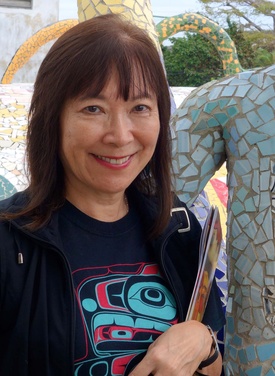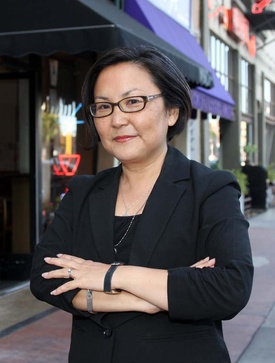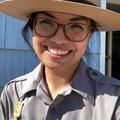The Japanese American experience is rarely tackled in mainstream literature. In 2015, Asian protagonists are still conspicuously absent from novels, missing in popular films, and seldom cast in leading theater roles. But we are not invisible. Asian American authors and artists in the past century have taken representation into their own hands, voicing their own life experiences through creative arts.
On September 19, the Japanese American National Museum will feature two such Asian American artists in an event titled Writing Little Tokyo in Crime and Rhyme. Poet Amy Uyematsu and novelist Naomi Hirahara will read from their most recent works—The Yellow Door (2015) and A Grave on Grand Avenue (2015)—and discuss the various cultural and literary influences that inspire their careers.
* * * * *
Amy Uyematsu’s newest work, The Yellow Door, is her fourth book of poetry. Preceding it were her debut 30 Miles from J-Town (1992), Nights of Fire, Nights of Rain (1998), and Stone Bow Prayer (2005). Her published poetry works are spaced out across a thirty-two year high school teaching career in Los Angeles, emerging one by one as products of years upon years of sideline work.
During a recent email interview, Uyematsu spoke about her original inspiration to write. Amidst math major requirements at UCLA in 1969, she took a class called “Orientals in America” taught by pioneering historian and Asian American social activist Yuji Ichioka. Her term paper was titled “The Emergence of Yellow Power in America.” In it she offered commentary on the image of the silent, submissive Oriental, and followed her well-chosen words with three poems. Both the paper and the poems were published that same year in Gidra, a well-known Asian American movement newspaper.
“I’m not sure why I included three poems at the end of the paper,” she mused in our interview. “Poetry, at the time, seemed to be the best vehicle for me to express all that I was going through during that tumultuous political and social era. It has continued to be an effective way for me to view the world and express what I see and feel.” This affinity with poetry led her to discover numerous other inspirations beyond her pioneering college instructor—this time, in the form of other Asian American poets including Garrett Hongo, Lawson Inada, and Janice Mirikitani.
Uyematsu no longer considers herself a radical social activist in 2015. Her continued association with the yellow pride movement emerges through poetic themes rather than explicit political writings. Her poems address everything from her own political opinions to her own experience growing up sansei in postwar L.A. to nature and spirituality. This wide variation of subject matter from the political to the personal to the aesthetic and spiritual is evident in her latest work The Yellow Door. In this newest book, she told me, she writes “about being a sansei with the added perspective of being an older baby boomer. The social commentary [also] continues, in poems like “No Shade Named Mongoloid” or “Riding the Yellow Dragon.”
Naomi Hirahara, joint presenter with Uyematsu at the JANM event, was not inspired to write by a socially conscious college professor. By comparison, this author got a very early start in writing as she found it was “a natural extension and response” to reading as a child. Her affinity for mystery in particular, though, took slightly longer to develop.
After earning a bachelor’s degree in international relations, she spent time abroad in Japan and Ghana before venturing back home to L.A. Her homecoming was soon followed with a new reporting job at The Rafu Shimpo. “I wasn’t a die-hard fan of [mysteries],” she admitted in an interview, “until I started working at The Rafu Shimpo newspaper. There I read authors like Walter Mosley and Barbara Neely and began to see how I could incorporate my love for American and L.A. subcultures into a popular genre that dealt with the sometimes dark reality of people’s lives.”
And surely there was no dearth of dark reality during Hirahara’s time at the newspaper. It coincided with both the culmination of the redress and reparations movement for Japanese Americans incarcerated during WWII, and the L.A. race riots.
Her first mystery novel, The Summer of the Big Bachi, was published in 2004 to great critical acclaim. Its protagonist is unusual—a 72-year-old Japanese American gardener named Mas Arai who, like Hirahara’s own parents, survived the 1945 atomic bomb in Hiroshima. The Summer of the Big Bachi was soon followed by four other whodunit challenges for Arai’s amateur skills and Hirahara is currently working on a sixth installation. Sayonara Slam will be released in May 2016.
Not, of course, to detract from another of her concurrent mystery series, which features a mixed half-Japanese detective named Officer Ellie Rush.
When asked about her major literary influences, Hirahara cites a wide array of classic and contemporary literature. Fyodor Dostoevsky, Charles Dickens, Louise Erdrich, Hisaye Yamamoto DeSoto, Toshio Mori, and the playwright Wakako Yamauchi, among many others, all inform her approach to recurring themes in her books—of identity, racial and class disenfranchisement, forgiveness, personal redemption, and family.
Uyematsu and Hirahara hail from very different genres of literature but both are proud L.A. natives. Their association stretches back over twenty years and now they will reunite at JANM on September 19, 2015 from 2 p.m.–4 p.m. There, they will recount their own writing journeys, and thus try their hands at inspiring a continuation of Asian American creative self-expression through poetry and mystery. Admission is free and open to the public.
© 2015 Kimiko Medlock








